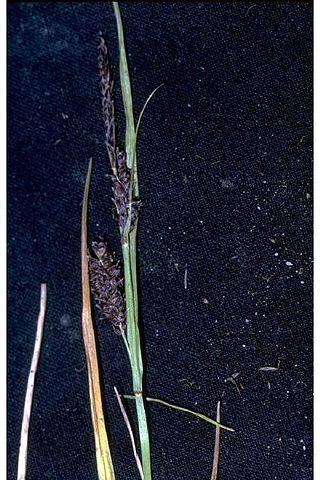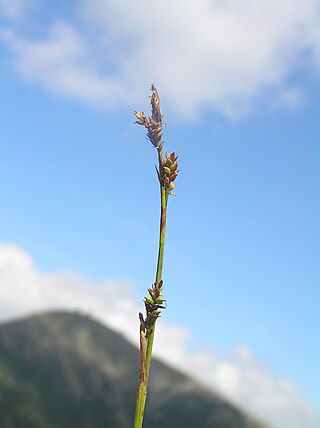Carex alma is a species of sedge known by the common name sturdy sedge. It is native to the southwestern United States and northern Mexico, where it grows in moist spots in a number of habitat types. This sedge forms a thick clump of thin stems up to 90 centimeters in length and long, thready leaves. The leaves have basal sheaths with conspicuous red coloration, often spotting. The inflorescence is a dense to open cluster of many spikelets occurring both at the ends of stems and at nodes. Each cluster is up to 15 centimeters long and 1 to 2 wide. The plant is sometimes dioecious, with an individual sedge bearing either male or female flowers. The female, pistillate flowers have white or white-edged bracts. The male, staminate flowers have visible anthers 2 millimeters long or longer. The fruit is coated in a sac called a perigynium which is gold to dark brown in color and has a characteristic bit of spongy tissue at the base.
Carex amplifolia is a species of sedge known by the common name bigleaf sedge. It is native to western North America from British Columbia to Montana to California, where it grows in wet and seasonally wet areas in coniferous forests.

Carex concinnoides is a species of sedge known by the common name northwestern sedge. It is native to western North America from British Columbia to California, where it can be found in moist or dry habitat, often in woodland and forested slopes, on silty and clay soils. This sedge produces loose clumps of stems up to about 35 centimeters in maximum height from long rhizomes. The leaves are thick but narrow, sickle-shaped, and pale green in color. Inflorescences occur at the stem tips, and some pistillate inflorescences grow from nodes along the stem. The spikelets have purplish bracts. The pistillate flowers have four stigmas on each pistil, an identifying characteristic. The fruit is coated in a sac called a perigynium, which is white to light brown in color, purple-tipped, and covered in hairs.

Carex diandra is a species of sedge known by the common names lesser tussock-sedge and lesser panicled sedge.

Carex disperma is a species of sedge known by the common names softleaf sedge or two-seed sedge. It is native to much of the northern Northern Hemisphere, from Alaska to Greenland, most of Canada and the contiguous United States, and across Eurasia.

Carex hoodii is a species of sedge known by the common name Hood's sedge. It is native to western North America from Alaska to Nunavut to California to South Dakota, where it grows in dry to moist habitat in forests and on mountain slopes.

Carex illota is a species of sedge known by the common name sheep sedge. It is native to western North America, where it grows in wet places such as marshes and mountain meadows, from New Mexico and California north to Western Canada.

Carex lutea is a rare species of sedge known by the common names golden sedge and sulphur sedge. It is endemic to North Carolina, where it is known only from Pender and Onslow Counties in the Cape Fear River watershed. There are nine populations. The plant was discovered in 1991 and described to science as a new species in 1994, and it has not been thoroughly studied nor completely surveyed yet. Its rarity was obvious by 2002, however, when it was federally listed as an endangered species.

Cypripedium passerinum is a species of lady's slipper orchid known by the common names sparrow's-egg lady's-slipper, spotted lady's-slipper, and Franklin's lady's-slipper.

Potentilla hippiana is a species of flowering plant in the rose family known by the common names woolly cinquefoil, horse cinquefoil, and Hipp's cinquefoil. It is native to North America, where it occurs in western Canada and the western United States. It occurs in eastern Canada and the US state of Michigan as an introduced species.

Carex bigelowii is a species of sedge known by the common names Bigelow's sedge, Gwanmo sedge, and stiff sedge. It has an Arctic–alpine distribution in Eurasia and North America, and grows up to 50 centimetres (20 in) tall in a variety of habitats.
Carex garberi is a species of sedge known by the common names elk sedge and Garber's sedge native to North America.

Carex inops is a species of sedge known as long-stolon sedge and western oak sedge. It is native to northern North America, where it occurs throughout the southern half of Canada and the western and central United States.

Carex livida is a species of sedge known by the common names livid sedge and pale sedge.

Carex saxatilis is a species of sedge known by the common names rock sedge and russet sedge.

Carex vaginata is a species of sedge known by the common name sheathed sedge.

Eriophorum viridicarinatum is a species of sedge known by the common names thinleaf cottonsedge, green-keeled cottongrass, and bog cottongrass. It is native to northern North America, where it occurs in Alaska and throughout much of Canada, its range extending into the northern contiguous United States. Its distribution is more patchy in the west but it is widespread in eastern Canada.

Kobresia simpliciuscula is a species of sedge known by the common names false sedge, simple bog sedge and simple kobresia. It has a circumpolar distribution, occurring throughout the northern latitudes of the Northern Hemisphere.
Carex oronensis is a species of sedge known by the common name Orono sedge. It is endemic to Maine in the United States, where it occurs mainly in the Penobscot River Valley. It is the only plant that is endemic to the state of Maine. The type locality is Orono.
Sisyrinchium sarmentosum is a species of flowering plant in the iris family known by the common names mountain blue-eyed grass and pale blue-eyed-grass. It is native to the Pacific Northwest of North America, where it is known from a part of the Cascade Mountains in Washington and Oregon.
















